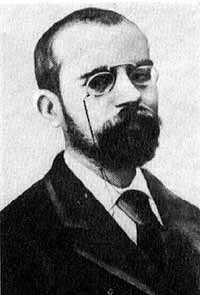- Leopoldo Alas y Ureña
Infobox Writer
name = Leopoldo Alas y Ureña

birthdate = birth date|1852|4|25|mf=y
birthplace =Zamora ,Spain
deathdate = death date and age|1901|6|13|1852|4|25|mf=y
deathplace =Oviedo ,Spain
occupation = Novelist, short story writer, journalist, critic, professorLeopoldo Alas y Ureña (
25 April 1852 -13 June 1901 ), also known as "Clarín" was a Spanish realist novelist born in Zamora. He died inOviedo .Alas spent his childhood living in León and Guadalajara, until he moved to
Oviedo in 1865. There he studied "Bachillerato" (high school) and he began hislaw career. He lived inMadrid from 1871 to 1878, where he began his career as a journalist and he graduated with thethesis "El Derecho y la Moralidad" ("Law and Morality"). He taught inZaragoza from 1882 to 1883. In 1883 he returned to Oviedo to take up a position as professor of Roman law.He is the author of books such as "
La Regenta ". It is a long work, similar to Flaubert's "Madame Bovary", one of its influences. Other influences included Naturalism and "Kraussism ", a philosophical current which promoted the cultural and ethical regeneration of Spain. He also wrote Nuevo viaje al Parnaso and La Literatura en 1881 (1882), in collaboration withArmando Palacio Valdes ."La Regenta" is special for its great wealth of characters and secondary stories, while the main character's description is left slightly unfocused and vague. On the other hand, the downfall of the provincial lady has place amidst two very diverse suitors: the most handsome man in the city, who triumphs in the end, and the cathedral's priest. The depiction of this priest is a key part of the book.
For the description of the
provincial atmosphere and the city's collective life, "Clarín" used techniques such as the internalmonologue or the free indirect style, which makes the story be narrated by the characters themselves and allows the reader to penetrate in their intimacy.In 1890, he published a new novel, "Su único hijo". Even though most critics consider it as a lesser novel in comparison with "La Regenta", it is equal to the former in skill with which the technical resources are used. "Su único hijo" was originally meant to be the introduction to a trilogy, but little remains of this trilogy aside from an outline and a few fragments of two of the novels. "Su único hijo" was Clarín's last full-length novel.
Apart from these works, "Clarín" is also the author of magnificent stories and of a large number of journalistic articles.
Leopoldo Alas remains a rather enigmatic figure in the Spanish literary world, leaving a legacy that encouraged the search for God and
humanism simultaneously. This aberrant confluence has facilitated the presence of various interpretations regarding the author's writings, most noticeably of his masterpiece, "La Regenta".Works
*"
La Regenta " (The Regent's Wife) (1884-85) [Novel]
*"Su único hijo" (His Only Son) (1890) [Novel]
*"Doña Berta " (1892)
*"¡Adiós, Cordera! " (1892)
*"Cuentos morales" (Moral Stories) (1896)
*"El gallo de Sócrates" (Socrates' Rooster) (1900)Essays
* "Solos de Clarín" (1881)
* "La literatura en 1881" (1882)
* "Sermón perdido" (1885)
* "Nueva campaña" (1887)
* "Ensayos y revistas" (1892)
* "Palique" (1894)External links
See also author
Wikisource=es:Leopoldo Alas ("Clarín")
Wikiquote=
Wikicommons=Leopoldo Alas ("Clarín")
Gutenberg=Leopoldo_Alas
Cervantes=16
DominioPu=1940
DomiPubli=1940
*
* [http://cervantesvirtual.com/bib_autor/Clarin/ A good website on the author, containing his works in digital version (In Spanish)]
* [http://www.classicistranieri.com/dblog/articolo.asp?articolo=2055 Works by Clarin in e-book version (In Spanish)]
Wikimedia Foundation. 2010.
